Count of Barcelona
The Count of Barcelona (Catalan: Comte de Barcelona, Spanish: Conde de Barcelona) was the ruler of Catalonia for much of Catalan history, from the 9th until the 15th century.

The County of Barcelona was created by Charlemagne after he had conquered lands north of the river Ebro. These lands, called the Marca Hispanica, were partitioned into various counties, of which the Count of Barcelona, usually holding other counties simultaneously, eventually obtained the primacy over the region.
As the county became hereditary in one family, the bond of the counts to their Frankish overlords loosened, especially after the Capetian dynasty supplanted the Carolingians.
In the 12th century the Counts formed a dynastic union with the Kingdom of Aragon, merging the two realms under a single ruler. In 1258, the king of France relinquished his feudal authority over the County in the Treaty of Corbeil.
Barcelona remained, as a part of the Principality of Catalonia, part of the Crown of Aragon when the latter around 1500 entered into a union with the Crown of Castile, thereby forming the Spanish Monarchy. Catalonia maintained its own laws, institutions, taxes and privileges until they were removed after the War of the Spanish Succession in the 18th century.
Count of Barcelona remained one of the many hereditary titles of the Spanish monarchy.
In the 20th century, the title regained some prominence when Juan de Borbón, the exiled heir to the Spanish throne, adopted the title of Count of Barcelona. In doing so, he claimed a historical royal title without claiming to be the current king of Spain, especially after his son Juan Carlos became the prospective successor of the then-ruler of Spain, Francisco Franco. In 1977, after Juan Carlos had become King upon Franco's death in 1975, he officially awarded the title of Count of Barcelona to his father, who had renounced his rights to the throne. Juan held that title until his death in 1993, when it reverted to the King who has held it ever since. Juan de Borbón's widow used the title Countess of Barcelona until her death in 2000.
List of Counts of Barcelona
Non-dynastic, 801-878
| Name | Portrait | Reign | Notes |
|---|---|---|---|
| Berà, Count of Barcelona | 801-820 | son of Guilhèm I of Razès, brother of Bello of Razès, also Count of Razès and Conflent (790-820), Girona, Besalú, Ausona (812/817-820), deposed. | |
| Rampon (Rampó) | 820-826 | also Count of Girona and Besalú | |
| Bernard I (Bernat I) | 826-832 | son of William of Gellone, also margrave of Septimania (834-835) and Imperial Chamberlain (829-830), deposed. | |
| Berenguer | 832-835 | also Count of Toulouse. | |
| Bernard I (Bernat I) | 836-844 | restored, executed on orders of Charles the Bald. | |
| Sunifred | 844-848 | son or son-in-law of Belló of Carcassone, also Count of Ausona, Besalú, Girona, Narbonne, Agde, Béziers, Lodève, Melgueil, Cerdanya, Urgell, Conflent and Nîmes. | |
| William (Guillem) | 848-850 | son of Bernard I, also Count of Toulouse (844-850), rebelled and was killed. | |
| Aleran | 850-852 | also Count of Empúries and Roussillon and Margrave of Septimania. | |
| Odalric | 852-858 | son of Hunfrid, Margrave of Istria, also Count of Girona, Roussillon, Empúries and Margrave of Septimania. | |
| Humfrid | 858-864 | son of Hunfrid II, Duke of Rhaetia, also Count of Girona, Empúries, Roussillon, and Narbonne and Margrave of Gothia. | |
| Bernard II (Bernat II) | 865-878 | son of Bernard of Poitiers also Count of Girona and Margrave of Gothia and Septimania, rebelled. | |
House of Sunifred, 878-1162
| Name | Portrait | Reign | Notes |
|---|---|---|---|
| Wilfred I (Guifré I) el Pelós (the Hairy) |  | 878-897 | son of Sunifred, managed to establish hereditary succession |
| Wilfred II Borrell I (Guifré II Borrell) | 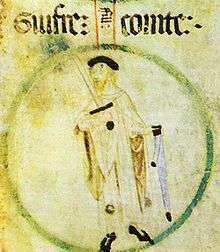 | 897-911 | son of Wilfred the Hairy |
| Sunyer |  | 911-947 | son of Wilfred the Hairy, retired to a monastery |
| Borrell II |  | 947-992 | son of Sunyer jointly with Miro (947-966) and Ramon Borrell (988-992), also Count of Urgell (948-992). Unsuccessfully asked King Lothair of France for aid against the Saracens, refused to recognise Hugh Capet as King of France in 987. The feudal link with France was broken, so that the County of Barcelona became independent de facto. |
| Miro | 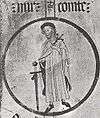 | 947-966 | son of Sunyer, jointly with Borrell II |
| Ramon Borrell | 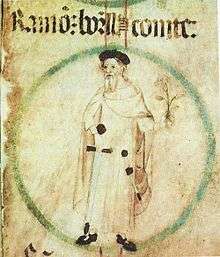 | 988-1018 | son of Borrell II, jointly with his father (988-992) |
| Berenguer Ramon I el Corbat (the Crooked) |  | 1018/1023–1035 | son of Ramon Borrell, under the regency of Ermesinde of Carcassonne (1018–1023), forced to recognise the suzerainty of Sancho the Great of Navarre. |
| Ramon Berenguer I el Vell (the Old) | 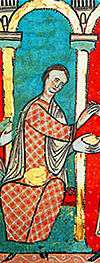 | 1035/1039–1076 | son of Berenguer Ramon I |
| Ramon Berenguer II el Cap d'Estopes (the Towhead) |  | 1076–1082 | son of Ramon Berenguer I, jointly with his twin brother Berenguer Ramon II |
| Berenguer Ramon II el Fratricida (the Fratricide) | 1076–1097 | son of Ramon Berenguer I, jointly with his twin brother Ramon Berenguer II (1076–1082) and later his nephew Ramon Berenguer III (1082–1097) | |
| Ramon Berenguer III el Gran (the Great) |  | 1082–1131 | son of Ramon Berenguer II |
| Ramon Berenguer IV el Sant (the Saint) |  | 1131–1162 | son of Ramon Berenguer III, engaged Petronilla of Aragon in 1137 and married her in 1150. |
The succession of Ramon Berenguer IV and Petronilla led to the creation of the Crown of Aragon.
House of Barcelona, 1164–1410
| Name | Portrait | Birth | Marriages | Death |
|---|---|---|---|---|
| Alphonse I the Troubadour 18 July 1164 – 25 April 1196 |  | 1157 Huesca son of Ramon Berenguer IV of Barcelona and Petronilla of Aragon | Sancha of Castile 7 children | 25 April 1196 Perpignan aged 44 |
| Peter I the Catholic 25 April 1196 – 13 September 1213 | 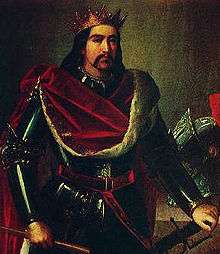 | 1178 Huesca son of alfons I and Sancha of Castile | Marie of Montpellier 15 June 1204 2 children | 12 September 1213 Battle of Muret aged ca. 35 |
| James I the Conqueror 13 September 1213 – 27 July 1276 |  | 2 February 1208 Montpellier son of Peter I the Catholic and Marie of Montpellier | Leanor of Castile 1221 1 child Violant of Hungary 1235 10 children Teresa Gil de Vidaure 2 children | 27 July 1276 Valencia aged 68 |
| Peter II the Great 27 July 1276 – 2 November 1285 |  | 1240 Valencia son of James I and Violant of Hungary | Constance of Sicily 13 June 1262 6 child | 2 November 1285 Vilafranca del Penedès aged 45 |
| Alphonse II the Liberal 2 November 1285 – 18 June 1291 |  | 1265 Valencia son of Peter II and Constance of Sicily | Eleanor of England 15 August 1290 No children | 18 June 1291 Barcelona aged 27 |
| James II the Fair 18 June 1291 – 2 November 1327 |  | 10 August 1267 Valencia son of Peter II and Constance of Sicily | Isabella of Castile 1 December 1291 No children Blanche of Anjou 29 October 1295 10 children Marie de Lusignan 15 June 1315 No children Elisenda de Montcada 25 December 1322 No children | 5 November 1327 Barcelona aged 60 |
| Alphonse III the Kind 2 November 1327 – 24 January 1336 |  | 1299 Naples son of James II of Aragon and Blanche of Anjou | Teresa d'Entença 1314 7 children Eleanor of Castile 2 children | 27 January 1336 Barcelona aged 37 |
| Peter III the Ceremonious 24 January 1336 – 5 January 1387 |  | 5 October 1319 Balaguer son of Alphonse III and Teresa d'Entença | Maria of Navarre 1338 2 children Leonor of Portugal 1347 No children Eleanor of Sicily 4 children | 5 January 1387 Barcelona aged 68 |
| John the Hunter 5 January 1387 – 19 May 1396 | 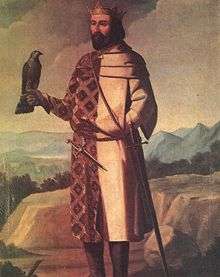 | 27 December 1350 Perpignan son of Peter III and Eleanor of Sicily | Martha of Armagnac 1 child Yolande of Bar 3 children | 19 May 1396 Foixà aged 46 |
| Martin the Humanist 19 May 1396 – 31 May 1410 |  | 1356 Girona son of Peter III and Eleanor of Sicily | Maria de Luna 13 June 1372 4 children Margaret of Prades 1409 No children | 31 May 1410 Barcelona aged 54 |
Martin was the last direct descendant of Wilfred the Hairy to rule; died without legitimate heirs (interregnum 31 May 1410 – 24 June 1412). By the Compromise of Caspe of 1412 the County of Barcelona and all its associated dominions passed to a branch of the House of Trastámara.
The County of Barcelona formed a constituent part of the Crown of Spain under the rule of the House of Habsburg, until the Nueva Planta decrees (1707 and 1716), when Philip de Bourbon declared that all the territories from the Crown of Aragon should merge into Castile, building the centralized Kingdom of Spain. In Barcelona this was promulgated in 1716, and the title of Count of Barcelona became one of the many unused hereditary titles of the modern Spanish monarchy.
Courtesy title
House of Bourbon, 1977–1993
| Name | Portrait | Reign | Notes |
|---|---|---|---|
| John III (Juan III) |  | 1977–1993 | claimed title from 1941; officially granted by his son Juan Carlos I in exchange for renouncing his claim to the Spanish throne |
References
See also
| ||||||||||||||||||||||||||||||||||||||||||